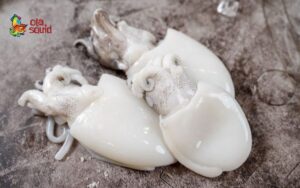If you are a lover of seafood cuisine, fresh squid is definitely an indispensable name on your weekly menu. Not only is it a popular and easy-to-prepare ingredient, but squid also possesses high nutritional value and a unique flavor that few other seafood can match. However, amidst a market that fluctuates daily, the price of squid is always a question that consumers ponder. So, what is the current price of fresh squid? What delicious and nutritious dishes can be made from squid? In the following article, Ola Squid will provide you with the most complete and detailed overview, don’t miss it!
Benefits of Fresh Squid
Before looking into squid prices, let’s review the wonderful health benefits that fresh squid offers.
Preventing Joint Problems
Fresh squid is rich in calcium, phosphorus, and natural collagen. These are three essential components that help form and maintain the strength and flexibility of the skeletal and joint system.
For the elderly, squid helps slow down the aging process, supporting the prevention of joint-related diseases such as osteoporosis, knee pain, and spinal degeneration. For young, active individuals, squid helps restore cartilage, limit injuries, and increase the durability and flexibility of the musculoskeletal system.
Good for Bones and Teeth
In addition to its benefits for bones, the calcium content in squid is also very good for teeth. Squid helps strengthen teeth, reducing the incidence of cavities, which is especially beneficial for young children in the stage of permanent tooth formation.
For children and adolescents, incorporating squid into their diet also contributes to promoting height growth. For pregnant women and new mothers, squid provides essential minerals without causing a feeling of fullness like some other meats.

Improving Cardiovascular Health
Squid is one of the natural foods with a high content of omega-3, a type of unsaturated fatty acid that is very beneficial for the heart. Omega-3 helps reduce bad cholesterol, increase good cholesterol, and improve blood vessel elasticity.
As a result, squid helps prevent high blood pressure, reduces the risk of atherosclerosis, and minimizes complications such as stroke or myocardial infarction. This is a very suitable food for middle-aged and elderly people, or those with a history of heart disease.
Relaxing Nerves and Regulating Blood Pressure
The nutritional composition of squid contains a large amount of taurine, an amino acid that plays an important role in balancing the activity of the central nervous system. Taurine helps soothe feelings of stress, reduce anxiety, and support people who frequently suffer from insomnia to regain deep and natural sleep.
Moreover, taurine also helps stabilize blood pressure, regulate heart rate, and improve blood circulation to the brain. This is an ideal choice for those who are often under work pressure, studying, or working in stressful environments.
Supporting Migraine Relief
Fresh squid also provides a rich source of magnesium – a mineral that helps relax smooth muscles, dilate blood vessels, and thereby helps reduce headaches and migraines. People who often suffer from stress and fatigue due to nervous pressure will feel lighter in spirit when squid is included in their daily diet.
In addition, magnesium, combined with iron in squid, contributes to improving blood circulation to the brain, enhancing memory and concentration. This is a very useful food for students, pupils, and those who engage in high-intensity intellectual work.
What is the Latest Fresh Squid Price on the Market?
With the increasing demand for squid consumption, squid prices fluctuate frequently depending on the season, fishing area, and product quality. Below is a reference price list compiled from major seafood markets and wholesale supermarkets:
| Type of Fresh Squid | Reference Price (VND/kg) | Characteristics |
| Medium Tube Squid (500-800g) | 300,000 – 350,000 | Tender, sweet meat, most common on the market |
| Large Tube Squid (over 1kg) | 350,000 – 400,000 | Thick meat, suitable for grilling or stuffed dishes |
| Fresh Roe Squid | 380,000 – 420,000 | Fatty, rich in roe, usually available during breeding season |
| Sim Squid (small cuttlefish) | 320,000 – 370,000 | Crispy, aromatic, suitable for salads or steaming |
| Sun-dried Squid (pre-processed) | 450,000 – 500,000 | Easy to preserve, rich flavor, specialty of Quang Ninh |
Note: Squid prices may vary depending on the region, time, and quality of the squid. You should check prices at reputable seafood stores to ensure you buy delicious squid at a reasonable price.
Characteristics to Identify Delicious Fresh Squid
Regardless of whether the squid price is cheap or expensive, the most important thing for consumers is the true freshness and deliciousness of the squid. This is because fresh squid not only helps the dish retain its characteristic flavor but also ensures nutritional value and health safety. Here are three key factors to help you identify truly high-quality fresh squid.
Whole, Fresh Squid
The first sign of a fresh squid is its external appearance. The squid should maintain its intact shape, the body should not be torn, the skin should not be peeling, and the tentacles should be firmly attached to the head.
When you touch the squid’s body, you will feel a distinct firmness and elasticity: not mushy, not soft and slimy, and not leaking water. In some cases, if the squid has just been caught or is freshly arrived, you might even notice a slight contraction when touched, which is an indication of “perfect” freshness.
Choosing intact squid not only ensures the quality of the meat but also helps retain the entire ink sac, roe, or baby squid inside – parts considered the “quintessence” in squid dishes.

Fresh Squid Eyes
The eyes are the part that most easily indicates the freshness of a squid. A good squid always has bright, clear eyes, with distinct dark pupils, not cloudy or covered by a white film. Upon closer inspection, you will see that the squid’s eyes appear lively – reflecting that the creature is still alive.
Conversely, squid that has been kept for a long time often has cloudy, sunken eyes, or a pale gray color – this is a sign that the squid is spoiled or has been frozen for a long time. These types of squid will have a bland, less sweet flavor when cooked and tend to become mushy. When shopping at markets or supermarkets, if you are unsure between different types with varying squid prices, always prioritize those with “alert” eyes; this is a clear indicator of the freshness of this seafood.
Bright Squid Body with Clear Red or Black Spots
Fresh squid always has a bright body, with a light silvery sheen, a smooth skin surface, and no dullness. A special point to note are the tiny black or red spots on the squid’s body – often called “mino.” These are natural pigments that are only clearly visible when the squid is fresh.
If you see the mino spots evenly distributed, distinct, and not smudged, it indicates that the squid is fresh and has not been stored for too long. Meanwhile, squid that has been kept for a long time or improperly frozen often has a dull body, loses its shine, and has almost no trace of mino.
Color is an easily judged factor with the naked eye, especially useful when buying squid at wholesale markets where there is a clear difference between fresh and preserved squid. Therefore, even if the squid price differs slightly, don’t hesitate to spend a little more to get truly fresh squid, as the difference will be clearly reflected in every dish.
What Delicious Dishes Can Be Made From Fresh Squid?
Once you have purchased quality fresh squid at a reasonable squid price, you can create countless delicious and attractive dishes. Here are some of the most popular squid dishes:
Grilled Squid
Grilled squid is a simple yet incredibly captivating dish, perfect for outdoor parties or gatherings with friends. The aroma of the squid mixed with the charcoal smoke will captivate everyone.
How to make: Clean the squid, make light scores on the body for the marinade to penetrate evenly. Marinate with minced garlic, fish sauce, satay, oyster sauce, and a little sugar for 20-30 minutes. Grill over charcoal or in an oven at 180-200°C until the squid is golden brown and fragrant. Serve with lime chili salt for a complete flavor.

Stir-fried Squid
Stir-fried squid is a nutritious, quick, and much-loved dish for family meals. The dish retains the natural sweetness of the squid, combined with fresh vegetables, creating a perfect balance.
How to make: Slice the squid into rings, blanch briefly in boiling water to remove any fishy smell. Quickly stir-fry with fried garlic, onion, bell peppers, and celery. Season with fish sauce, pepper, and oyster sauce to taste. Stir-fry over high heat to maintain the crispness of the squid and vegetables.
Stuffed Squid with Meat
Stuffed squid with meat is a sophisticated, nutritious, and flavorful dish. The combination of fresh squid and a delicious meat filling will make your meal richer.
How to make: Prepare the filling with minced pork, wood ear mushrooms, vermicelli, shallots, pepper, and seasonings. Stuff the filling into cleaned squid bodies after removing the backbone. Steam for about 10 minutes or fry until golden brown on both sides. Serve hot with sweet and sour fish sauce or tomato sauce as desired.
Squid Salad
Squid salad is a refreshing appetizer that stimulates the appetite and balances out oily meals. The crispiness of the squid combined with fresh herbs creates a harmonious and pleasant flavor.
How to make: Boil the squid until just cooked, then soak in ice water to maintain its crispness. Thinly slice the squid, mix with Vietnamese mint, onion, carrots, and sweet and sour fish sauce dressing. Let it marinate for about 10 minutes before serving.

Stir-fried Noodles with Squid
Stir-fried noodles with squid is a convenient dish, suitable for a quick breakfast or dinner that is still full of nutrition. The delicious flavor and attractive color make the dish memorable.
How to make: Boil the noodles until al dente, drain well. Stir-fry squid rings with fried garlic, then add carrots, cabbage, and green onions. Add the noodles and stir-fry together with soy sauce, oyster sauce, pepper, and a little sugar. Stir-fry over high heat to prevent the noodles from drying out.
Squid Hot Pot
Squid hot pot is an ideal choice for cool weather, allowing you and your family to gather and enjoy the rich flavor of the ocean.
How to make: Cook the broth from simmered bones or coconut water, add lemongrass, tomatoes, tamarind, or sour leaves for a mild sourness. Clean the squid, cut into bite-sized pieces, and dip when the broth is boiling. Serve with mushrooms, green vegetables, and fresh rice noodles.
Squid Cake
Squid cake is a famous specialty from the coastal region of Ha Long, known for its moderate chewiness and rich, distinctive flavor from fresh squid.
How to make: Pound or grind fresh squid with pork fat, shallots, pepper, and seasonings. Shape into flat patties and fry in hot oil until golden and crispy. Serve with rice or sticky rice.
Notes on Eating Squid and How to Store Squid
To ensure health safety and preserve the natural freshness and deliciousness of squid, you need to pay attention to some important points when using and storing this seafood. Eating squid correctly and storing it properly will help you fully enjoy the deliciousness and avoid unwanted side effects.
Notes on Eating Squid
First of all, although squid is a nutritious food, you should also consider health issues when consuming it.
Avoid Eating if You Have a History of Allergies
Squid belongs to the group of seafood that easily causes allergies in many people. If you have experienced symptoms such as rashes, itching, difficulty breathing, or severe allergic reactions after eating squid or seafood, limit or absolutely avoid consumption to prevent dangerous consequences for your health.
Ensure Squid is Fully Cooked
Undercooked squid may contain parasites or disease-causing bacteria, which are especially dangerous for young children, the elderly, or people with weakened immune systems. Therefore, ensure that squid is fully cooked before eating to protect the health of the whole family.

Do Not Consume with Beer or Alcohol
Eating squid with beer or alcohol can lead to digestive disorders, bloating, or other unpleasant reactions. If you want to enjoy squid without negative effects, prioritize drinking water or light beverages to neutralize and aid digestion.
How to Store Squid
After buying squid, proper storage will help maintain its freshness and prevent spoilage, especially when you cannot cook it immediately.
Storing Squid Without a Refrigerator
If you don’t have a refrigerator, you can salt the squid and store it in an ice cooler or a cool, dry place. However, squid should not be left in these conditions for more than 6 hours as it will quickly lose its freshness and spoil, affecting the quality of the dish.
Storing Squid in the Refrigerator
Before storing, clean the squid, drain it, and then seal it in a zip-top bag or a covered plastic container. If you plan to use it within 1-2 days, you can store it in the refrigerator’s fresh food compartment. To preserve it for longer, you should freeze the squid in the freezer. When you need to cook it, thaw it slowly in the refrigerator compartment to ensure quality and food safety.
Understanding these notes on eating squid and applying the correct storage methods will not only help you protect your health but also preserve the delicious and fresh flavor of the dish. Through this, you will fully enjoy the culinary pleasure from this nutritious seafood.
Regularly update the latest squid prices from reliable sources and don’t forget to save delicious squid recipes to enrich your daily meals. We wish you always have warm, fulfilling, and flavorful meals with your family, enjoying delicious dishes made from fresh squid.
For delicious dried squid products, please visit our home page, or explore our shop. You can also find specific categories such as dried squid snacks, flattened dried squid, and whole dried squid.


 Tiếng Việt
Tiếng Việt ไทย
ไทย




